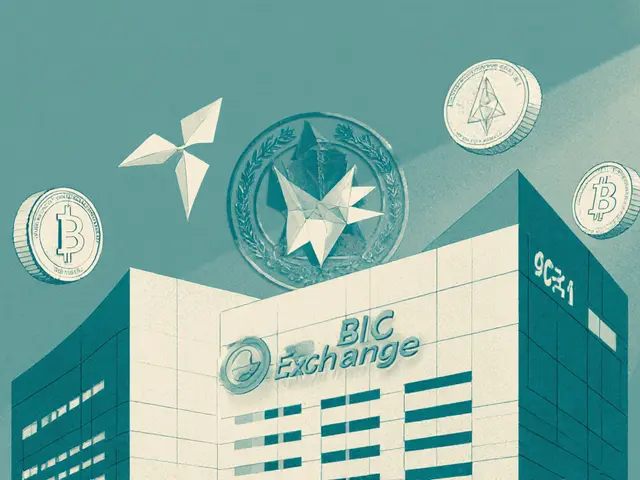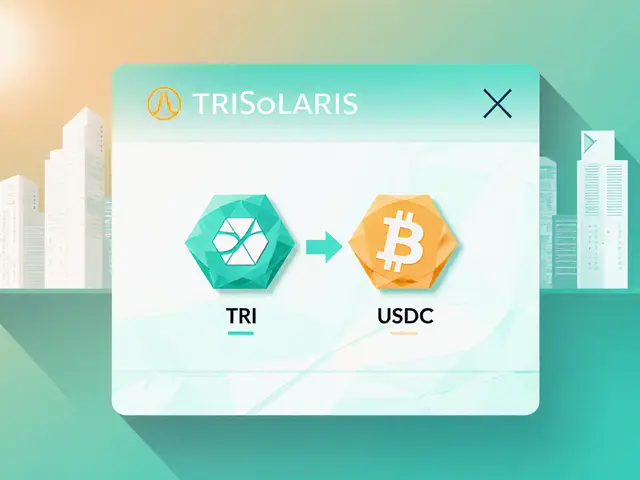SpiritSwap Fee Calculator
Fee Breakdown
Total Transaction Fee: $0.00
Fee Distribution:
- Liquidity Providers:
- SPIRIT Stakers:
Note: SpiritSwap charges a flat 0.30% fee on all trades, split evenly between liquidity providers and SPIRIT stakers.
Popular Token Pairs on SpiritSwap
MIM/WFTM
Most Active Pair
WFTM/USDC
Stablecoin Pair
FTM/MIM
Core Fantom Pair
SPIRIT/FTM
Governance Pair
When you hear the name SpiritSwap is a decentralized exchange (DEX) built on the Fantom Opera Chain that uses an automated market maker (AMM) model similar to Uniswap. In plain English, it lets you trade tokens without an order book, relying on liquidity pools that anyone can fund. Launched in 2021, it aims to give Fantom users fast, cheap swaps and extra earnings through yield farming and staking. This review breaks down how the platform works, what you pay, how safe it feels, and whether it stacks up against the big DEX players.
Quick Take
- Operates on Fantom, offering sub‑second swaps and near‑zero gas fees.
- Charges a flat 0.30% fee for both makers and takers; fees are split between liquidity providers and SPIRIT stakers.
- Supports 32 coins and 40 pairs, with MIM/WFTM as the busiest market.
- Yield farming and SPIRIT token staking add passive‑income options.
- Security is decent-audited contracts, but no formal regulation and modest traffic (≈670 organic visits/month).
What Is SpiritSwap and Where Does It Live?
The platform lives on the Fantom Opera Chain, a high‑throughput, low‑cost blockchain that launched in 2020. Because Fantom processes thousands of transactions per second, SpiritSwap can execute swaps in under a second and keep gas fees close to zero-a stark contrast to Ethereum’s often‑expensive network.
SpiritSwap follows the Uniswap constant‑product AMM model. Instead of matching buyers and sellers, the protocol holds pools of two tokens (e.g., MIM and WFTM). Traders trade against the pool, while the algorithm keeps the product of the two reserves constant, guaranteeing a price at any moment.
Fees, Spreads, and Trading Mechanics
Every transaction on SpiritSwap incurs a 0.30% fee, split evenly between the liquidity providers (LPs) and the protocol’s governance token holders. The fee structure is simple-no tiered discounts, no maker‑vs‑taker distinction-but the split incentivizes both supplying liquidity and staking the native token.
Actual market spreads average about 0.703% across the 40 pairs. For most retail traders, that’s comparable to other DEXs on layer‑1 chains, while still far cheaper than centralized exchanges that charge 0.25‑0.5% plus hidden costs.
Leverage is capped at 1:1, reflecting the platform’s focus on spot swaps rather than margin trading. Funding is wallet‑only; you’ll need a compatible DeFi wallet like MetaMask, Trust Wallet, or the Fantom‑specific Frame.
Token Coverage and Liquidity Landscape
SpiritSwap lists 32 distinct coins and 40 trading pairs. While the list isn’t as expansive as Uniswap’s thousands‑of‑token catalog, it covers the core Fantom ecosystem-FTM, WFTM, MIM, USDC, and a few emerging DeFi projects.
Liquidity is provided by everyday users who become Liquidity Providers. When you deposit an equal‑value pair into a pool, the AMM algorithm uses those assets to facilitate trades. In return, you earn a slice of the 0.30% fee and any SPIRIT rewards if the pool is part of a boosted farming program.
Yield Farming, Staking, and the Role of SPIRIT
Beyond simple swapping, SpiritSwap offers yield farming. By locking tokens into specific pools, you receive extra SPIRIT token rewards. SPIRIT itself is a multifunctional asset:
- Fee payment: You can use SPIRIT to cover the 0.30% fee, effectively getting a discount equal to the token’s market price.
- Governance: Holders vote on protocol upgrades, fee adjustments, and new pool launches.
- Staking rewards: Staking SPIRIT for defined periods yields ETH‑denominated incentives, with rates scaling by both amount and lock‑up duration.
These incentives aim to bootstrap liquidity, a common challenge for newer DEXs. However, the overall reward rates are modest compared with PancakeSwap’s high‑APR farms, reflecting SpiritSwap’s smaller user base.

Security, Audits, and Regulatory Landscape
SpiritSwap’s smart contracts have undergone at least one third‑party audit (the report is publicly posted on the platform’s GitHub). No major exploits have been recorded to date, and the protocol has a bug‑bounty program that pays out for verified vulnerabilities.
From a regulatory standpoint, the exchange operates fully decentralized and is not registered with any financial authority, as confirmed by FxVerify. That means no KYC/AML checks, which is great for privacy but also means you bear full responsibility for compliance in your jurisdiction.
Given the low traffic (≈670 organic visits per month) and a bounce rate of 43%, the community is modest but active. The platform’s Alexa rank (~514,619) places it far behind the top DEXs, so expect occasional UI hiccups and fewer educational resources.
How SpiritSwap Stacks Up: Quick Comparison
| Feature | SpiritSwap | Uniswap (Ethereum) | SushiSwap (Multi‑chain) |
|---|---|---|---|
| Primary Chain | Fantom Opera | Ethereum | Ethereum, BSC, Polygon, etc. |
| 24h Volume (USD) | ~$4,100 | ~$2.3B | ~$1.1B |
| Fee | 0.30% (flat) | 0.30% (standard) | 0.25% - 0.30% |
| Token Incentives | SPIRIT rewards + ETH staking | UNI governance token | SUSHI rewards + dual‑incentive farms |
| Supported Tokens | 32 coins / 40 pairs | Thousands | Thousands across chains |
| Typical Swap Speed | ~0.5s (Fantom) | ~12s (Ethereum, congested) | ~5s (varies by chain) |
In short, SpiritSwap wins on speed and cost thanks to Fantom, but it lags in volume, token variety, and brand recognition.
Pros & Cons Checklist
- Pros
- Near‑zero gas fees on Fantom.
- Fast transaction finality.
- Simple 0.30% fee split encourages LP participation.
- SPIRIT token adds governance and staking yields.
- Mobile‑first UI makes on‑the‑go swaps easy.
- Cons
- Limited token list compared to major DEXs.
- Low overall liquidity; large trades can cause slippage.
- Modest traffic means fewer community resources.
- No formal regulatory compliance-risk for newcomers.
- Yield farming rewards are lower than high‑APR competitors.
Step‑by‑Step: Getting Started on SpiritSwap
- Install a DeFi‑compatible wallet (MetaMask, Trust Wallet, or the Fantom Frame app).
- Switch your wallet network to Fantom Opera (add RPCURLif needed).
- Visit the official SpiritSwap site (verify the URL ends in .io).
- Click “Connect Wallet” and approve the connection in your wallet.
- Select the token you want to trade (e.g., swap MIM for WFTM).
- Enter the amount, review the price impact and expected slippage, then confirm.
- If you want to earn rewards, navigate to the “Farms” tab, pick a pool, and deposit the required token pair.
- To boost earnings, stake SPIRIT in the “Staking” section and choose a lock‑up period.
That’s it-no KYC, no email, just crypto in, crypto out, plus optional passive income.
Future Outlook and Market Position
SpiritSwap sits in the 42nd volume percentile among DEXs, a modest standing that reflects both its niche focus and the fierce competition from Ethereum‑centric platforms. The platform’s biggest growth lever will be the continued adoption of Fantom. If Fantom’s ecosystem expands-more dApps, higher TVL-the demand for a native, low‑cost swap will rise, pulling more LPs into SpiritSwap’s pools.
Price predictions for the SPIRIT token illustrate the uncertainty: forecasts range from $0.000011 (very bearish) to $0.000931 (optimistic) for 2030. While token price isn’t the sole measure of exchange health, a higher SPIRIT value would make farming more attractive, potentially lifting liquidity.
Key risks include:
- Liquidity fragmentation: users may split between SpiritSwap and larger DEXs for better depth.
- Regulatory shifts: emerging DeFi regulations could affect how unregistered platforms operate.
- Technical competition: New layer‑2 solutions on Ethereum could replicate Fantom’s low‑fee advantage.
Overall, if you’re already inside the Fantom ecosystem, SpiritSwap offers a fast, cheap gateway to trade and earn. For traders seeking deep liquidity and a wide token list, mainstream DEXs remain a better fit.
Frequently Asked Questions
Is SpiritSwap safe to use?
The platform’s contracts have been audited and no major hacks have been reported. However, because it’s unregulated and has low traffic, you should only trade amounts you’re comfortable risking and keep your wallet’s private keys secure.
How do I earn SPIRIT rewards?
Provide liquidity to eligible pools in the “Farms” section, then claim SPIRIT rewards. You can also stake SPIRIT itself to receive ETH‑denominated bonuses, with higher rates for longer lock‑up periods.
What wallets work with SpiritSwap?
Any wallet that supports the Fantom network works-MetaMask, Trust Wallet, Frame, and hardware wallets like Ledger (via MetaMask) are common choices.
Can I use SpiritSwap on mobile?
Yes. The web UI is responsive, and most mobile wallets integrate directly, letting you swap tokens from your phone without a desktop.
How does the 0.30% fee get distributed?
Half of the fee goes to the liquidity providers of the pool you traded in. The other half is allocated to SPIRIT token stakers, boosting their staking rewards.





Matt Nguyen
One must first acknowledge the clandestine machinations that underpin any ostensibly transparent DeFi platform, and SpiritSwap is no exception. The veneer of speed and low fees masks a deeper, orchestrated agenda to divert capital away from more reputable exchanges. While the Fantom chain touts sub‑second finality, this very swiftness is leveraged by shadowy actors to execute front‑running attacks before the average user can react. The flat 0.30% fee, though seemingly benign, is a fiscal conduit through which these hidden benefactors amass wealth under the guise of liquidity incentives. Audits, as the post mentions, are performed, yet the audit firms themselves are often in collusion with the very projects they certify. Moreover, the SPIRIT token distribution model, rewarding stakers with ETH‑denominated bonuses, creates a feedback loop that enriches early insiders while the latecomers merely subsidize the system. The limited token list is not a drawback of technology but a deliberate throttling to ensure market control remains within a closed circle. Even the modest traffic statistics-670 organic visits per month-serve to keep the community small enough to avoid scrutiny by regulators or investigative journalists. In this environment, the promise of “near‑zero gas fees” is a seductive bait, luring users into a comfort zone where they relinquish vigilance. The platform’s reliance on a single blockchain also centralizes risk; any exploit or governance attack on Fantom would cascade directly onto SpiritSwap’s users. The governance token, SPIRIT, ostensibly democratizes decision‑making, yet the voting power is heavily weighted toward large token holders, effectively silencing the rank‑and‑file. Users should therefore view the audited contracts not as an absolute guarantee of safety but as a potential veneer crafted by a consortium of interested parties. It is prudent, therefore, to diversify across multiple DEXs, maintain rigorous personal security practices, and remain skeptical of any platform that markets simplicity as an end‑goal. Ultimately, the onus lies with the individual trader to decipher whether the convenience offered truly outweighs the covert risks embedded within the protocol’s architecture.
Rob Watts
Keep pushing forward you got this keep swapping and learning.
Bhagwat Sen
Alright, let me just jump in here because I think the community needs a reality check. SpiritSwap’s speed is cool but you’re still at the mercy of pool depth-if you try to move a lot of capital, you’ll see slippage that can wipe out any fee advantage. Also, those SPIRIT rewards? They sound great until you remember the token’s price volatility can turn your “earnings” into a loss faster than you can say "impermanent loss". And yes, the platform is audited, but remember that audits are a snapshot, not a shield against future exploits. If you’re new to DeFi, start small, test the UI, and keep an eye on the gas costs even on Fantom-they’re low but not zero. Lastly, don’t ignore the community forums; often the real-time tips and warnings come from other users before any official announcement.
Cathy Ruff
Honestly this thing is overrated its token list is tiny and you’ll get ripped off by slippage if you try to do anything serious.
Amy Harrison
Love the low fees and super fast swaps on SpiritSwap! 🎉 The UI feels really smooth on mobile, and earning SPIRIT while you trade is a nice bonus. If you’re already on Fantom, this is definitely worth a try. Keep the good vibes rolling! 😊
Adarsh Menon
Wow, another “revolutionary” DEX that promises the world and delivers a handful of pairs. I’m sure the “near‑zero” gas fees are just a myth conjured by marketers who never actually traded there. The 0.30% fee? Yeah, that’ll eat your gains faster than a hungry cat on a mouse. And those SPIRIT rewards sure sound tempting until you realize you’re basically getting paid in a token that might be worth next to nothing. If you’re looking for excitement, maybe try swapping on a platform that actually has something to offer beyond empty hype.
Laurie Kathiari
It’s downright irresponsible to promote a platform with such thin liquidity without a warning about the moral implications. Users are being lured into a system that benefits a tiny elite, while the average trader bears the brunt of slippage and hidden risks. The promise of “fast and cheap” swaps is a veneer that masks the underlying exploitation of novice participants. Those who champion these DEXs without acknowledging the broader ethical context are complicit in perpetuating financial inequity.
Jim Griffiths
SpiritSwap works well for small trades. The fee is flat and the UI is clean.
Promise Usoh
From a philosophical standpoint, the adoption of low‑fee DEXs such as SpiritSwap represents a signifcant shift toward decentralised financial suystem. However, the inherent risks, including smart contract vulnerablities and market manipulation, must not be understated. Users should engage with measured caution, ensuring they possess sufficient technical understanding before committing capital.
Lurline Wiese
Oh dear, another DEX promising miracles while the reality is a thin pool of liquidity that could crumble at any moment! The drama of hype versus substance is ever‑present, and SpiritSwap is no exception. Its sleek UI may seduce the unsuspecting, but the underlying economics are fraught with peril.
Jenise Williams-Green
Everyone seems to love SpiritSwap for its speed, yet they conveniently ignore the fact that low fees often correlate with lower security standards. I’d rather trust a more established platform even if it costs a bit more, because cutting corners on safety is a false economy.
Kortney Williams
I think it’s great that there are options like SpiritSwap for those on Fantom, but cooperation among projects would help users more than competition.
Eva Lee
From a technical perspective, SpiritSwap’s AMM architecture leverages the constant‑product formula to maintain market equilibrium across its limited token pairs. However, the depth of liquidity is constrained, leading to elevated price impact for larger order sizes. The protocol’s fee redistribution mechanism, allocating half to LPs and half to SPIRIT stakers, introduces a dual‑incentive vector that can be attractive for yield‑oriented participants. Nonetheless, the platform’s modest TVL suggests a comparatively lower resilience to market shocks relative to tier‑1 DEXs.
stephanie lauman
It’s clear that SpiritSwap’s design is a front for the hidden cabal steering the DeFi space. The audit reports are likely fabricated to lull the masses into a false sense of security. 🧐💥
Twinkle Shop
When considering the broader ecosystem dynamics, SpiritSwap occupies a niche that aligns with the overarching strategic objectives of the Fantom network’s scalability roadmap. The platform’s sub‑second transaction finality not only enhances user experience but also serves as a catalyst for downstream integration with decentralized applications seeking low‑latency liquidity services. Moreover, the SPIRIT token’s dual role-as a governance instrument and a fee discount mechanism-introduces a multi‑layered incentive structure that, while ostensibly beneficial, warrants careful scrutiny regarding tokenomic sustainability. From a regulatory standpoint, the absence of KYC procedures positions SpiritSwap within the gray area of financial compliance, potentially exposing participants to jurisdiction‑specific legal ramifications. Nevertheless, for users whose risk tolerance tolerates such ambiguity, the combination of near‑zero gas costs, rapid settlement, and modest fee architecture offers a compelling proposition, especially when juxtaposed against the high‑fee environments prevalent on legacy chains. Ultimately, the platform’s success will hinge upon continued community engagement, liquidity depth expansion, and the ability to navigate evolving regulatory landscapes without compromising the core ethos of decentralization.
Jim Griffiths
Matt you’ve raised many valid points on risk. For everyday users I’d suggest starting with tiny swaps to get a feel for the UI and fee impact before scaling up.
Amal Al.
Amy, your enthusiasm is uplifting! Just remember to monitor the SPIRIT reward rate, as it can fluctuate; staying informed will help you maximize those earnings.
Taylor Gibbs
Eva, great breakdown of the technical aspects. For newcomers, pairing that knowledge with step‑by‑step guides can bridge the gap between theory and practice.